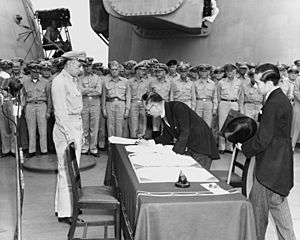Surrender of Japan facts for kids
The surrender of Imperial Japan happened in 1945, marking the end of World War II. Japan's Emperor Hirohito announced the surrender on August 15, 1945. The official signing took place on September 2, 1945.
By late July 1945, Japan's navy was very weak. The Allied forces, including the United States, the British Empire, and China, were planning a large invasion of Japan. They demanded Japan's full surrender in a message called the Potsdam Declaration on July 26, 1945.
A major reason for Japan's decision to surrender was the use of atomic bombs by the United States. These powerful bombs were dropped on the cities of Hiroshima and Nagasaki.
Contents
What Led to Japan's Surrender?
Japan had been fighting in World War II for many years. By 1945, the war was going very badly for them. The Allied forces had won many battles in the Pacific Ocean. They were getting closer and closer to Japan itself.
The Potsdam Declaration
In July 1945, leaders from the United States, Britain, and China met in Potsdam, Germany. They issued the Potsdam Declaration. This document told Japan to surrender completely. If Japan did not surrender, the declaration warned of "prompt and utter destruction." Japan's leaders did not accept this demand right away.
The Atomic Bombs
The United States then used a new and terrible weapon: the atomic bomb.
- On August 6, 1945, an atomic bomb was dropped on Hiroshima. This bomb destroyed most of the city and caused many deaths.
- On August 9, 1945, a second atomic bomb was dropped on Nagasaki. This also caused massive destruction and loss of life.
These bombings showed Japan that the Allies had a powerful new weapon. They made the Japanese government realize they could not continue fighting.
Soviet Union Joins the War
Also on August 9, 1945, the Soviet Union declared war on Japan. Soviet forces quickly invaded Japanese-controlled areas in Manchuria (a region in China). This added more pressure on Japan's leaders to end the war.
Japan's Decision to Surrender
Japan's leaders were divided. Some wanted to keep fighting, even if it meant more destruction. Others, including Emperor Hirohito, believed that continuing the war would only lead to more suffering for the Japanese people.
Emperor Hirohito's Role
Emperor Hirohito played a key role in the decision. After the atomic bombings and the Soviet invasion, he decided that Japan must surrender. He believed it was the only way to save his country.
The Announcement
On August 15, 1945, Emperor Hirohito spoke to the Japanese people in a radio broadcast. This was the first time many Japanese people had ever heard the Emperor's voice. He announced that Japan had accepted the terms of the Potsdam Declaration. This meant the war was over.
The Formal Signing of Surrender
The official surrender ceremony took place on September 2, 1945. It happened aboard the American battleship USS Missouri in Tokyo Bay.
Who Signed the Surrender?
- Japanese Foreign Minister Mamoru Shigemitsu signed for the Emperor of Japan.
- General Yoshijirō Umezu signed for the Japanese Imperial General Headquarters.
- General Douglas MacArthur signed for the Allied Powers.
- Representatives from other Allied nations, like the United States, China, Britain, the Soviet Union, Australia, Canada, France, the Netherlands, and New Zealand, also signed.
This ceremony officially ended World War II.
After the Surrender
After the surrender, the Allied forces, mainly the United States, occupied Japan. They helped Japan rebuild and create a new, peaceful government. This period of occupation lasted until 1952.
Images for kids
See also
 In Spanish: Rendición de Japón para niños
In Spanish: Rendición de Japón para niños













